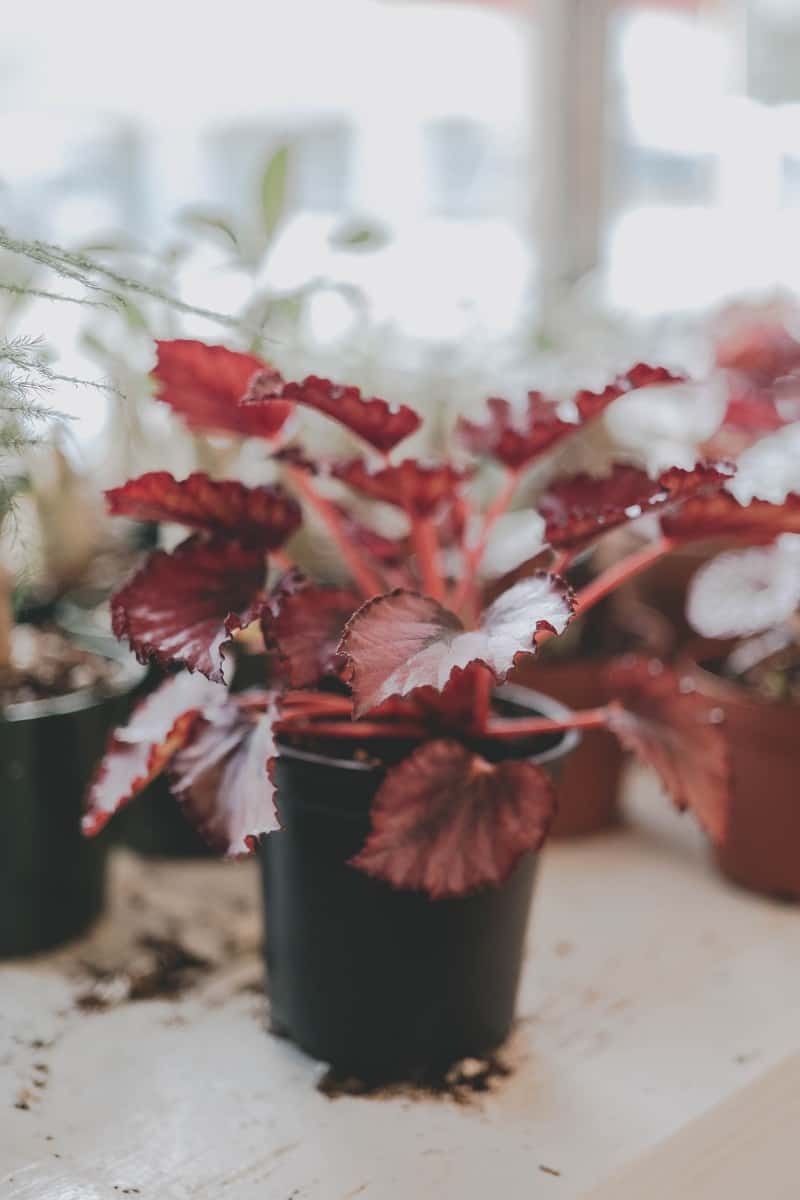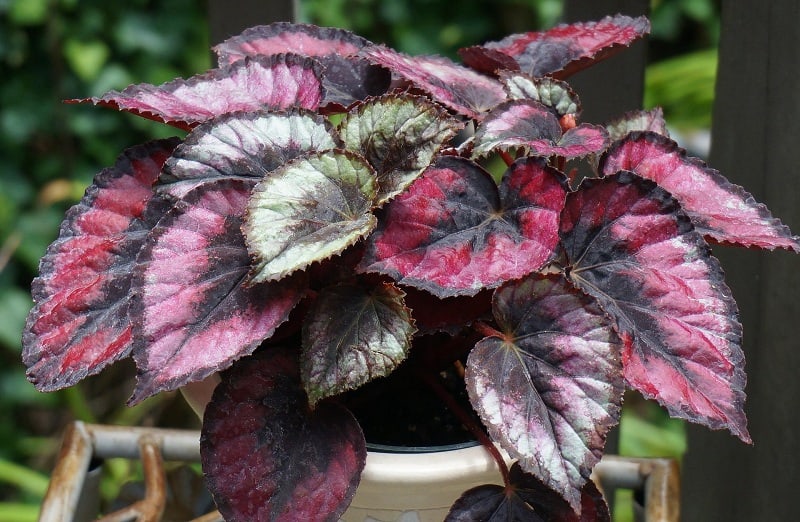Rex begonias are a type of tropical plant that is grown for its colorful leaves. They are native to South America and prefer warm, humid climates. Rex begonias can be grown as houseplants or outdoors in containers.
Rex begonias (Begonia rex) are tropical plants prized for their showy, often colorful leaves. They make beautiful houseplants and can also be grown outdoors in containers in warm, humid climates. Rex begonias come in a wide range of colors, including shades of green, red, pink, and white.
Begonia rex is a beautiful and unique plant that makes a great addition to any home. The plant is relatively easy to care for, and they make a great choice for both beginner and experienced gardeners alike.
| Name | Rex begonia |
| Botanical Name | Begonia rex-cultorum |
| Family | Begoniaceae |
| Plant Type | Herbaceous perennial |
| Light | Part shade to full shade |
| Native Area | Northeastern India, South America, and southern China |
| Toxicity | Toxic to animals |
How To Grow Rex Begonia
To grow Rex Begonia, start by planting the begonia in well-drained soil in a spot that gets partial sun. Then, water the begonia regularly, making sure the soil is moist but not soggy.
In addition, fertilize the begonia every other week during the growing season. To encourage blooming, provide the Begonia with 12 hours of darkness each night. Finally, pinch back the stem tips regularly to encourage a fuller plant.
How To Care Rex Begonia
If you’re thinking about adding a Rex Begonia to your indoor plant collection, here are a few things to keep in mind for care. First, Rex Begonias prefer indirect sunlight, so a spot near a window is ideal.
Second, these plants like to be kept moist, but not soggy, so water when the top inch of soil is dry. Third, fertilize every two to four weeks during the growing season with a half-strength solution. And finally, Rex Begonias are susceptible to mealybugs, so keep an eye out for these pests and treat them accordingly.

Light
The Rex begonia is a beautiful plant that originates from tropical forests. It’s a popular houseplant because it’s easy to care for and tolerates a wide range of indoor conditions. One important thing to remember when caring for a Rex begonia is that it needs bright, indirect light. So if you’re looking for a plant to brighten up your home, the Rex begonia is a great option!
Soil
No specific soil is required for Rex begonia, but a well-draining potting mix is best. Begonias do not like to sit in wet soil, so make sure the pot has drainage holes. You can also add perlite or vermiculite to the potting mix to improve drainage.
Water
Water your Rex Begonia when the top of the soil feels dry to the touch. Allow the water to seep through the drainage holes at the bottom of the pot, and then empty out any water that remains in the saucer. Begonias are susceptible to root rot, so it’s important to make sure they’re not sitting in water.
Temperature
The ideal temperature for a Rex Begonia is between 65 and 75 degrees Fahrenheit. However, they can tolerate temperatures as low as 60 degrees Fahrenheit.
Humidity
The Rex Begonia prefers humidity and will do best in a terrarium or other enclosed container with ample moisture in the air. mist the leaves daily and be sure not to allow the soil to dry out. Begonia Rex can also be placed in a saucer of water, with the saucer filled just enough to come up the sides of the pot slightly.
The ideal humidity for rex begonia is around 50%. However, they will tolerate a range of 40-60%.
Fertilizer
There are a few things to keep in mind when fertilizing rex begonias. First, they are heavy feeders, so you’ll need to use a fertilizer with high nitrogen content.
Second, they appreciate a little extra potassium, so look for a fertilizer with a higher potassium content than nitrogen.
Third, rex begonias need to be fertilized more often than other plants, so be sure to follow the directions on the fertilizer label.
Rex Begonias Types
There are three types of Rex Begonias- rhizomatous, fibrous-rooted, and corm-like. Rhizomatous Rex Begonias have a thickened, fleshy root system. They are the most commonly grown type of Rex Begonias and are easy to care for.
Fibrous-rooted Rex Begonias have a network of thin, fibrous roots. They are less common than rhizomatous Rex Begonias and can be more difficult to care for. Corm-like Rex Begonias have a thickened, tuberous root system. They are the least common type of Rex Begonias and can be more difficult to care for.
Rex Begonia Propagating
To propagate Rex begonia, you can use stem cuttings or rhizome cuttings. For stem cuttings, cut a 4-inch piece of stem from a healthy plant. Cut the stem just below a leaf node. Remove the bottom leaves from the stem, and dip the cut end in rooting hormone. Place the stem cutting in a pot of moistened potting mix.
For rhizome cuttings, cut a 2-inch piece of rhizome from a healthy plant. Cut the rhizome just below a leaf node. Dip the cut end in rooting hormone. Place the rhizome cutting in a pot of moistened potting mix. Water the potting mix well, and place it in a warm, bright location.
Keep the potting mix evenly moist. The stem cutting should produce roots in 4 to 6 weeks. The rhizome cutting should produce roots in 6 to 8 weeks.
Potting and Repotting Rex Begonias
If your Rex begonia is starting to look a bit cramped in its pot, it’s time for a potting and repotting makeover. Here’s what you’ll need to do:
- Choose a new pot that’s about two inches wider and two inches deeper than the current pot.
- Fill the bottom of the pot with fresh potting mix.
- Gently remove the begonia from its current pot, being careful not to damage the root ball.
- Place the root ball in the new pot and fill in around it with fresh potting mix.
- Water the begonia well and place it in bright, indirect light.
After a week or so, your Rex begonia will be happily settled into its new home.
Common Pests
Rex begonias are commonly attacked by various pests, including aphids, mealybugs, whiteflies, and spider mites. These pests can cause damage to the plant by sucking the sap out of the leaves, which can eventually lead to the leaves turning yellow and dropping off.
In severe cases, the plant may even die. To help control these pests, it is important to regularly inspect your plant and remove any pests that you see. You can also try spraying the plant with an insecticide or using predatory insects, such as ladybugs, to help control the pests.
Plant disease
There are several common diseases that can affect Rex Begonias, including powdery mildew, leaf spot, and root rot. Powdery mildew is a white, powdery fungus that can cover the leaves and stems of the plant. Leaf spot is a disease that causes brown or black spots to form on the leaves. Root rot is a serious disease that can kill the plant.
Common Problems With Rex Begonias
There are a few problems that are commonly associated with Rex Begonias, such as leaf spot, stem rot, and root rot. These problems can often be caused by over-watering or by improper drainage.
Leaf spots can be caused by a number of different things, such as too much sun, not enough water, or even a reaction to chemical fertilizers. If you see spots on the leaves of your Rex Begonia, try to determine the cause and take steps to correct it.
Stem rot is a serious problem that can kill your plant. It is often caused by too much water, which can cause the plant’s roots to rot. If you see signs of stem rot, such as soft or mushy stems, cut away the affected parts of the plant and make sure to improve the drainage in the pot.
Root rot is another serious problem that can be caused by too much water. If you see signs of root rot, such as yellowing leaves or stunted growth, you will need to repot the plant in fresh, well-drained soil. Be sure to take care not to over-water your plant in the future.
Pruning
Pruning your Rex Begonias can help to encourage new growth and keep your plant looking its best. To prune, simply cut back any lanky or overgrown leaves, stems, or flower heads. You can also remove any leaves that have turned brown or black. Be sure to sterilize your pruning tools before use to avoid spreading diseases.
How to grow rex begonia From Seed
If you want to grow rex begonia from seed, it’s actually not that difficult. All you need is a little patience and some basic supplies. First, purchase some quality begonia seeds from a reputable source. Next, fill a seed-starting tray with a sterile, well-draining potting mix. moisten the mix well, then sow your seeds thinly across the surface. Cover the tray with a clear lid or plastic wrap to create a mini greenhouse effect, then place it in a warm spot out of direct sunlight. Check on your seeds daily, and keep the mix moist but not soggy.
In 10-14 days, you should see little sprouts poking through the surface of the mix. Once they reach 2-3 inches tall, you can transplant them into small pots or peat pots filled with a regular potting soil mix.
How to Get rex begonia to Bloom
To get rex begonia to bloom, you need to provide it with bright indirect sunlight and keep the soil moist but not soggy. fertilize it every two weeks with a balanced fertilizer during the growing season. Rex begonias prefer slightly acidic soil, so if your soil is alkaline, you can add peat moss or compost to help lower the pH.
FAQ
What is the difference between Begonia and Begonia rex?
The Begonia rex is a type of begonia that is known for its decorative leaves. The leaves of the Begonia rex are usually more brightly colored than those of other begonias, and they often have interesting patterns. The Begonia rex is a popular plant for use in gardens and as houseplants.
How long do Rex begonias live indoors?
Rex begonias can live indoors for a long time if they are cared for properly. They need bright, indirect light and evenly moist soil. They can be sensitive to drafts, so make sure they are not in a spot where they will be exposed to cold air. With proper care, Rex begonias can last for many years.
Should I mist my rex begonia?
If you are misting your Rex Begonia, you should do so sparingly. These plants do not like to have their leaves constantly wet, so misting them once or twice a week should be sufficient.

